History of the bodhrán
History of the bodhrán
In the last 70 years the bodhrán has changed and developed like no other instrument in Irish music, maybe even like no other instrument at all. What happened before the last years?
Liam Ó Bharáin, among others, has done fundamental research on the origin of the bodhrán and published it here. It is to him that I refer in this section.
The Bodhrán is a frame drum. Frame drums are found in different forms all over the world. The origins are uncertain, although there is an obvious similarity to the tambourine that is found in the south of continental Europe. It might have come to Ireland through trade routes, but there is no final proof for that. There is also no proof for use as a war drum. I have no idea where that thought came from.
The name „Bodhrán“ comes from the irish word bodhar, meanig deaf, dull or numb. The word Bodharaí stands for a hollow sound, the sound of a drum etc. The English word "to bother" derives from "bodhar", which is not in use anymore in today's Irish.
Origins
The earliest evidence of the use of the word bhodhrán comes from a 15th century writing, a medical manual describing a distended belly with the sound of a drum (bhodhrán). (Rosa Anglica, see picture)
In old encyclopedias the word was found in use before 1827.
Pictures of the Irish painter Maclise, published around 1850, show a frame drum on which the left hand of the player seems to touch the skin and the right hand seems to move in the typical way.

Daniel Maclise
In one of his pictures, "Snap-Apple Night", based on a Halloween party in Blarney in 1833, show a frame drum on which the left hand of the player seems to touch the skin and the right hand seems to move in the typical way. The slide show shows a detailed view of the painting.
(Daniel Maclise - * 25. Januar 1806, Cork, Ireland; † 25. April 1870 , Chelsea, Irish history, literary and portrait painter)
The Bodhrán in the 20th and 21st Century
The bodhrán played a role as a musical instrument even in the first half of the 20th century, and was certainly played in session and at dances. It also has a role as a ritual instrument. Today, the transitions are seen as rather fluid.
The Ritual Instrument
Wren Boys
Even before the 1950s, the bodhran was played on St Stephens Day (26 December) in a ritual known as "Hunting the Wren". The Wren Boys accompanied the subsequent ceremony with whistles and bodhran-like drums....
Ultimately, the origin may be a Samhain or midwinter sacrifice and/or celebration, as Celtic mythology considered the Wren a symbol of the past year (the European wren is known for its habit of singing even in mid-winter, and sometimes explicitly called "Winter Wren"); Celtic names of the Wren (draouennig, drean, dreathan, dryw etc.) also suggest an association with druidic rituals. The tradition may also have been influenced by Scandinavian settlers during the Viking invasions of the 8th-10th Centuries.
Various associated legends exist, such as a Wren being responsible for betraying Irish soldiers who fought the Viking invaders by beating its wings on their shields, in the late first and early second millennia, and for betraying the Christian martyr Saint Stephen, after whom the day is named. This mythological association with treachery is a possible reason why the bird was hunted by Wrenboys on St. Stephen's Day, and/or why a pagan sacrificial tradition was continued in Christian times.

The Musical Instrument
First half of the 20th century
By now there are also numerous references to the use of the bodhrán as a musical instrument from the first half of the last century.
Bodhran maker James "Sonny" Davey not only made bodhráns for tourists in the 1920s, but was confronted with an increasing demand from musician circles.
There are several recordings of traditional Irish music with frame drums from the USA. The bodhráns of the time often had "jingles", i.e. metal plates or coins attached to the frame, similar to a tambourine.
Furthermore, there are book excerpts that document the use of the bodhran at musical gatherings.
Whereas in the past it was assumed that the bodhrán was a ritual instrument and only found its way into Irish music with the folk revival in the 1950s and 1960s, today it is assumed that it was in parallel use much earlier.
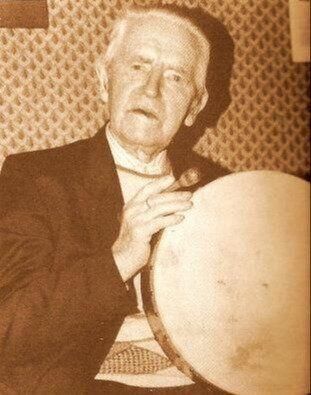
James (Sonny) Davey
Further research shows that in some areas of Kerry there were bodhrán makers as early as 1920, who made drums not only for local musicians, but also as souvenirs!
From Liam Ó Bharáin: Bodhrán: its origin, meaning and history
"James (Sonny) Davey, from Bunanadden, Ballymote in County Sligo, made his first bodhran some time between about 1917, when he was eight years of age, and 1920, when he was 12 (Schiller, 2001; Vallely, 1999). He related to Rina Schiller (2001) how the first bodhran he owned was made by an 'old flute player' and that he went to the crossroads (this would have been to crossroads dances) accompanying him on the bodhran.
He first made a bodhran himself for a man who approached him in a hall in Bunanadden 'where we were having a tune'. Davey was apparently accompanying the fiddler Fred Flynn at an event in the hall. James relates that he was shown how to cure goatskin by a Donegal man.
He had a workshop organised and was making bodhrans commercially with an emphasis on the tourist trade by 1927. Some of these early bodhrans bore the inscription 'Souvenir of Ireland'. Schiller goes on to relate how he soon gave up the tourist trade to concentrate on making bodhrans in response to a strong demand for his product from musicians in Ireland." (Schiller, 2001; Vallely, 1999).
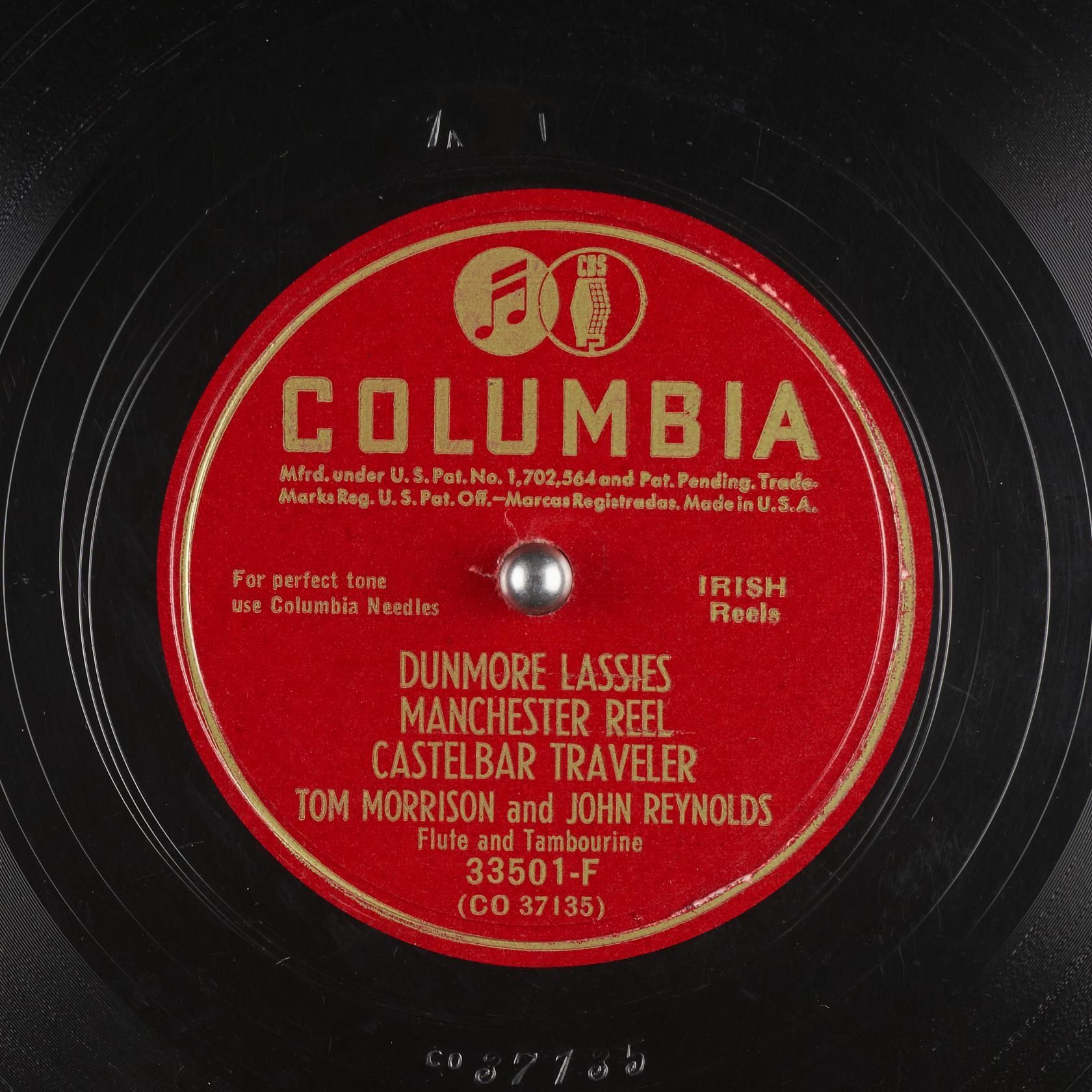
Early Recodings
The first recordings of tambourine or bodhrán come from America. Irish music emigrated to the USA with emigrants and was very popular there in the 1920s. The first two recordings were made by Tom Morrison and flute player John Reynolds:
Dunmore Lassies / Manchester Reel / Castelbar Traveler:
Sweet flowers of Milltown / The boys from Knock
The third recording is by Neal Smith with fiddle player Packie Dolan:
First of May

Willie Reynolds
In his book, Memories of a music maker, piper and button accordion player Willie Reynolds describes his experiences as a musician in the period around 1930-1945.
Here he describes a scene at a session at Colly's of Washford, Ballymore, ca. 1941 - 1942.
"I saw as many as a dozen musicians perform.", and then "You had the old man playing the fiddle and the two sons Tommie and Tim piping. Then there were Dan Molloy, Mick Kincaid, Tom Carty (all fiddlers) and a couple of Bodhrán players."
Various bodhran players are mentioned by name in the book:
Paddy Wade, Davy Norton, Paddy Kelly, Pat Kilduff, Ted Cahill, Davy Fallon, Jim (Gandhi) Daly, Peter Cassells.
Davy Fallon later became the Chieftains' first bodhrán player. By then he was no longer the youngest and was considered an experienced bodhrán player. This also shows that the bodhrán must have played a role before the Folkrevival, since he must have gained his experience somewhere.
Here is a wonderful documentary by Ruairi Glasheen. A must watch!
Second half of the 20th century
When Sean O'Riada started bringing traditional Irish music to the stage in the 1950s, he decided: "The bodhrán is the national drum". That opened the way and over time the drum has continued to spread through bands like the Chieftains.
The drum has evolved and continues to do so today, as there are always innovative ideas. From the tuning system to different frame depths and dimensions to different types of skins, there has been and still is a lot of experimentation.
The first bodhráns were rather loud and of low quality. The way of playing was either with a stick or with the hand, the skin hand did not touch the skin, sometimes there were jingles attached to the frame.
Over time, the sound was cleaned up: The bells disappeared, the skin was dampened with the skin hand and the playing technique was refined.
In the last decades, players like Peadar Mercier, Johnny "Ringo" McDonagh or John Joe Kelly have brought the drum and the playing technique to where it is now.
Peadar Mercier was one of the first players to use the drum in a band's context with the Chieftains after Sean O'Raida. Johnny McDonagh was the first to dampen the sound and change pitch with his left hand.
John Joe Kelly brought in rhythms from other music in his melodic playing during the nineties.
Innovative bodhran makers and tippermakers who have taken the drum and tippermakers to a new level have also been involved. These include Seamus O'Kane, Darius Bartlett, Victor Barral, Brendan White and Christian Hedwitschak as well as tippermakers such as Ralf Siepmann, Gordon Falconer, David Draeger and Stevie Moises.
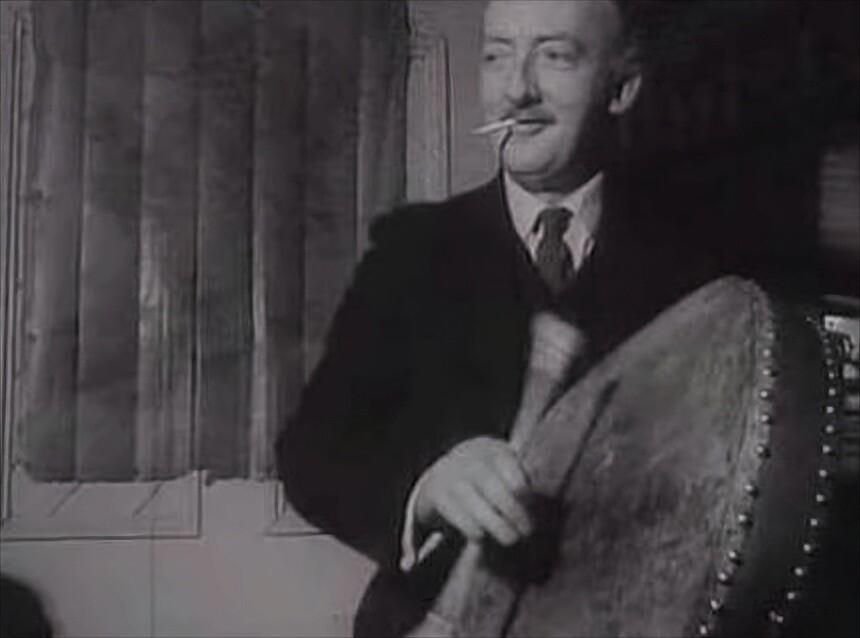
Seán Ó Riada
Seán Ó Riada (1 August 1931 - 3 October 1971), was a composer and perhaps the single most influential figure in the revival of Irish traditional music during the 1960s. He became a household figure in Ireland through his participation in Ceoltóirí Chualann, compositions, writings and broadcasts on the topic.
Between 1961 and 1969 Ó Riada was leader of Ceoltóirí Chualann. Although they played in concert halls dressed in a black suits with white shirts and black bow ties, they played traditional songs and tunes. Ó Riada sat in the middle at front playing bodhrán, a hand-held frame-drum. The membership of Ceoltóirí Chualann overlapped with membership of The Chieftains.
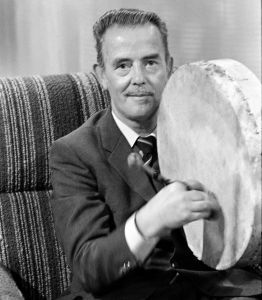
Peadar Mercier
Known as a member of the Chieftains, in 1966 he followed David Fallon as the Chieftains second bodhrán player. He played with them until 1976, when he was repalced by Kevin Conneff. You can hear him on the albums Chieftains 2 to 5. He also recorded with Dolores Keane and the Reel union (There was a maid, 1978 and on the album „Tin Whistles“ von Paddy Moloney und Sean Potts (1973). His son, Mel Mercier, is also well known as a bodhrán player.

Johnny McDonagh
From Celtic Music Net:
A true innovator among bodhránai, Johnny invented several groundbreaking techniques that actually extended the musical vocabulary of the instrument, such as the backslide and playing on the rim. McDonagh can also lay claim to being the first to play a bodhrán with a brush, as well as originating the idea for a tunable bodhrán. He also has left a valuable legacy in the annals of recorded Irish music, playing with De Danann and Arcady, and backing up premier solo Irish music acts from Eileen Ivers to Mary Bergin. Born in Galway on the 30th of March 1951. Tommy Hayes, who after all should know about such things, has declared McDonagh the bodhran's finest traditional player. But Johnny has balanced traditional music with extended side trips to other musical styles. McDonagh has gone the Irish music route in his stints with De Danann and Arcady.
But he also joined up with Mike Oldfield in 1979 and went on tour all over Europe, resulting in the live double-disc Exposed, offering interesting live performances of Tubular Bells and other Oldfield classics. Johnny recorded nine albums with De Danann from the early ‘70s to the late ‘80s, when he left the group to form Arcady.
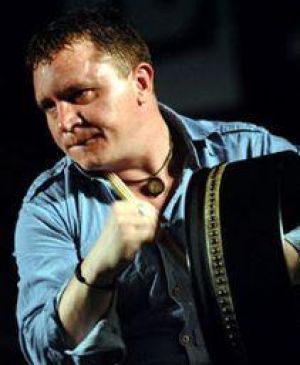
John Joe Kelly
John Joe Kelly is considered one of the most influential Bodhrán players of the last decades.
Growing up in Manchester, he became a member of the group Flook in the 90s, with whom he recorded several CDs.
His style is modern, innovative and has absorbed influences that go far beyond traditional Irish music. His playing is characterised by high tonal differences, and he was one of the first to play complete drum set grooves on the bodhrán. Depending on the context, however, he is also a restrained, groovy session accompanist.
He has influenced generations of players.
The last decades
Players and playing techniques
In addition to those mentioned above, players such as Jim Higgins, Junior Davey, Damien Quinn, Mossie Griffin, Donal Lunny, Christy Moore, Mel Mercier, Frank Torpey, Colm Murpyh, Rónán Ó Snodaigh (Kíla), Donnchadh Gough (Danu) and Tommy Hayes have, of course, been influential in shaping and continue to shape the style we know today.
More recently, players such as Martin O'Neill (Stevie Wonder, among others), Eamon Murray (Beoga), Cormac Byrne, Brian Morrissey, Colm Phelan (Goitse), Robbie Walsh, Aimee Farrell-Courtney, Siobhán O'Donnell, and many, many more have come along, all with a certain traditional background, but who have also brought influences from other genres.
In addition, there are players who come from a percussion context and have discovered the bodhrán as an instrument for themselves. This again brings new influences to the whole bodhrán scene. These players include Matthew Bell - snare/drumset/percussion, Andy Kruspe - drum instructor, Stevie Moises - drummer and tippermaker and Dave Boyd - percussionist.
Young players like Adam Brown (Imar), Eamon Nugent, Craig Baxter or Joseph McNulty, James Hurrell O'Connor and James O'Connor show that we will have a lot of fun with very good bodhrán players for many years to come. (These lists do not claim to be complete!)
Production
All these playing styles also create new challenges for the sound and playability of the drums. If you are going to play on stage, you need a reliable instrument that also fits your own playing style. This has also led to many innovations in bodhrán making and tipper making.
Tuning systems, preferably without tools, have prevailed.
The bodhrán was subjected to detailed sound analyses when Christian Hedwitschak and I carried out a larger project with the University of Munich. This was made possible by replaceable heads (ChangeHED), also an innovation from Hedwitschak.
Other manufacturers are experimenting with new materials or working techniques.
In general, a lot of things boil down to a specialisation of sound preferences. Custom made drums, i.e. drums that meet the customer's requirements both in terms of sound and appearance, have thus become possible. Also innovative: signature lines - bodhráns designed according to the sound ideas of professional players, as can be found here in the shop.
It is now possible for a bodhrán maker to produce drums with fundamentally different sounds. With the tippers, specific sound ideas are also implemented and signature tippers are also produced.
So the production is shifting from hobby makers to professional makers. I am very happy to be able to work with two professionals (Christian Hedwitschak and Stevie Moises).
Outlook
A lot has also changed in the environment of the bodhrán: Today the bodhrán is much better accepted, due to better drums and better players, and the beginner thus finds an ideal environment. There are good instruments that sound good right from the start, and there are workshops, online videos and teaching material, all of which make it very easy to get started.
In terms of playing styles, there is an increasing tendency to combine very modern styles with high tonality and the more traditional playing styles.
In terms of manufacturing, there is a trend to add easy-to-play synthetic skins to the skin selection and to use new materials.
So the development is by no means finished! But that's good, it just shows the great variety we find in this wonderful instrument!
My litte presentation during the Craiceann bodhrán summer school
I had the honour to talk about the history of the bodhrán focusing on the last two decades (2000-2023) during the bodhrán summer school Craiceann.
My litte presentation during the Craiceann bodhrán summer school
Here at folknews I did an interview about the history of the bodhrán. You may be interested in my motivation for delving into the history of our instrument.




